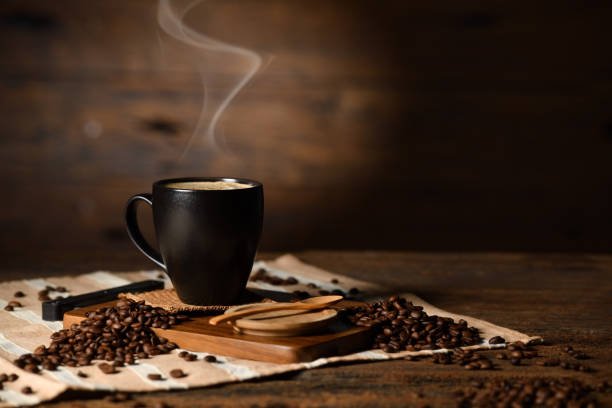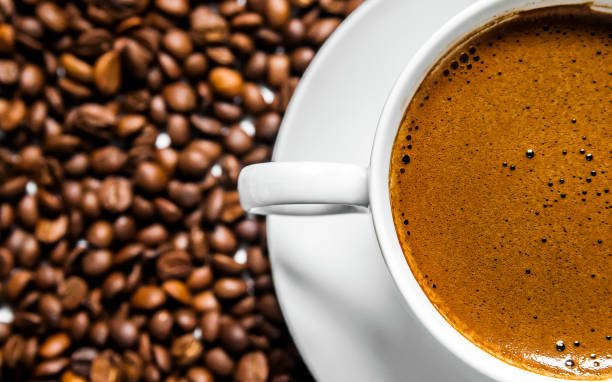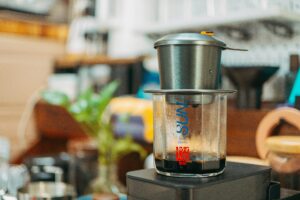Ever stared into the gleaming depths of your espresso machine, wondering, “Can I just use regular coffee beans for espresso?” We’ve all been there, that moment of craving a rich, crema-topped espresso shot without a dedicated bag of “espresso beans” on hand. The answer, like a perfectly brewed cup, is a nuanced one. Buckle up, coffee enthusiast, because we’re about to delve into the fascinating world of coffee beans and their suitability for espresso brewing!
Table of contents
The Espresso Enigma: Unveiling the Brewing Method
Unlike a standard cup of drip coffee, espresso is a concentrated shot brewed using finely-ground coffee and pressurized hot water. Imagine it as a high-pressure artistic technique that uses intense heat and precision to create a bold and concentrated masterpiece in a tiny cup. Regular coffee brewing, on the other hand, is like a gentle watercolor wash – beautiful, but with a different level of intensity.
The Bean Factor: Choosing the Right Canvas
So, can any coffee bean be used for espresso? Technically, yes. However, for optimal results, certain bean characteristics come into play:
- Roast Level: Darker roasts are generally preferred for espresso. The darker roast profile yields a richer flavor and body, better suited to withstand the high pressure of espresso brewing. Think of using bolder, more saturated colors for your espresso “painting” compared to lighter, more delicate hues.
- Freshness: Freshness is paramount for any brewing method, but especially for espresso. Freshly roasted beans are packed with flavor and aroma, translating to a more vibrant and delicious espresso shot. Imagine using fresh paints for the most vivid and long-lasting artwork!

The Grind Game: Size Matters in Espresso
Here’s where things get interesting. Unlike drip coffee, espresso requires a very fine grind. Think of it as the brushstrokes – too coarse, and the water won’t extract enough flavor; too fine, and it can lead to a bitter and over-extracted shot. A proper espresso grind is like the perfect brushstroke size – not too thick, not too thin, just right for capturing the essence of the coffee bean.
Beyond the Bean: The “Espresso Blend” Advantage
While technically any coffee bean can be used for espresso, there’s a reason why “espresso blends” exist. These blends are carefully crafted by roasters, combining different bean origins and roast levels to create a profile specifically designed for espresso brewing. Imagine these blends as pre-mixed color palettes specifically designed for a particular artistic style, like landscapes or portraits. They offer consistency and a flavor profile optimized for the espresso brewing process.
The Regular Coffee Experiment: Can It Work?
So, you’re still wondering – can you use your regular coffee beans for espresso in a pinch? The answer is, with a few caveats:
- Flavor Profile: Regular coffee beans, especially lighter roasts, might not deliver the bold and rich flavor profile typically associated with espresso. Think of using a color palette not typically associated with landscapes, like bright pinks and purples – it might not be the most traditional approach.
- Dialing In the Grind: You’ll need to experiment with a finer grind setting on your grinder to compensate for the different bean characteristics. Imagine having to adjust your brushstroke size and pressure depending on the paint you’re using.
- Potential for Bitterness: There’s a higher chance of over-extraction and bitterness with regular coffee beans due to their potentially lower oil content and lighter roast. Imagine accidentally using too much paint, leading to a muddy and overwhelming artwork.
The Final Sip: Espresso with Regular Beans – A Calculated Risk
In a pinch, using regular coffee beans for espresso can work. However, be prepared to adjust the grind size, manage your expectations for flavor, and potentially deal with a touch of bitterness. For the most consistent and delicious espresso experience, investing in a bag of freshly roasted, dark-roasted espresso beans is the way to go. After all, the right tools and materials make all the difference in creating a masterpiece, be it a vibrant espresso shot or a stunning work of art!
Beyond the Cup: Exploring the World of Coffee Brewing Methods
The beauty of coffee lies in its versatility. While espresso offers a bold and concentrated experience, other brewing methods like drip coffee, pour-over, or cold brew highlight different aspects of the bean’s flavor profile. Think of it like having a vast art supply store at your disposal – different tools and techniques for creating an array of artistic expressions. So, experiment, explore, and find the brewing method that best suits your taste and mood!
The Art of the Blend: Unveiling the Magic of Espresso Blends
We mentioned espresso blends earlier, those carefully crafted combinations of beans designed specifically for espresso brewing. Let’s delve deeper into this fascinating world:

The Symphony of Flavors: How Blends Create Harmony
Espresso blends combine different coffee bean origins, each with its unique flavor profile. Imagine blending different colored paints to create a specific shade or a multi-hued masterpiece. For example, a blend might combine:
- Latin American Beans: Known for their rich chocolatey notes and balanced acidity, these provide the foundation of the espresso flavor. Think of them as the base colors in your palette.
- African Beans: These often contribute bright citrusy or floral notes, adding complexity and liveliness to the blend. Imagine adding pops of vibrant color to your artwork.
- Asian/Pacific Beans: These can offer unique characteristics like spice or stone fruit notes, further enriching the flavor profile. Think of incorporating unexpected colors or textures to create a truly unique piece.
The Roasting Expertise: Achieving Balance
The different bean origins in an espresso blend are often roasted to varying degrees. Imagine using a combination of light and dark paints to create highlights and shadows in your artwork. This allows for a balanced flavor profile:
- Darker Roasts: These provide the body and richness expected in espresso, while also contributing some bitterness. Think of using dark paints to create a bold and dramatic foundation.
- Lighter Roasts: These can add a touch of acidity and fruity notes, balancing the bitterness and offering a touch of complexity. Imagine using lighter paints to add highlights and create a more nuanced piece.
The Blenders’ Art: A Skillful Craft
The art of crafting an espresso blend lies in the meticulous selection of beans, roast profiles, and final ratios. Imagine a skilled artist meticulously choosing colors, mixing them just right, to create a harmonious and visually stunning artwork. Experienced roasters use their expertise to create blends with:
- Consistency: Espresso blends aim to deliver a consistent flavor profile, shot after shot. Think of a pre-mixed color palette that consistently produces beautiful results.
- Complexity: The combination of origins and roasts creates a layered and interesting flavor profile, much like a painting with depth and detail.
- Predictability: Espresso blends are designed to work well with the high-pressure brewing process, ensuring a good extraction and minimal waste. Imagine using paints specifically formulated for a particular artistic technique, like watercolors, to ensure optimal results.
The Final Grind: Choosing the Right Blend for You
With a vast array of espresso blends available, how do you choose the right one? Here are some tips:
- Flavor Profile: Do you prefer a bold and intense espresso, or something with more nuanced fruity notes? Consider your taste preferences. Think about the mood you want to evoke with your artwork – bold and dramatic, or light and airy?
- Roast Level: If bitterness is a concern, opt for a blend with a lighter roast component. Consider your tolerance for certain colors in your palette.
- Explore and Experiment: Don’t be afraid to try different blends to discover your favorites. Embrace the world of coffee art and find the perfect “palette” for your espresso cravings!
So, the next time you reach for a bag of coffee beans, remember: while you can technically use regular coffee for espresso in a pinch, venturing into the world of espresso blends unlocks a whole new level of flavor exploration and consistency. With a little knowledge and experimentation, you can become a master of espresso brewing, crafting shots that are as beautiful and complex as any work of art!






